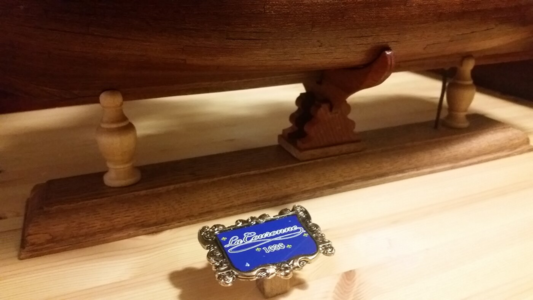- Joined
- Dec 29, 2020
- Messages
- 61
- Points
- 58

Are you suppose to use CA glue on all the knots when doing rigging
 |
As a way to introduce our brass coins to the community, we will raffle off a free coin during the month of August. Follow link ABOVE for instructions for entering. |
 |
 |
The beloved Ships in Scale Magazine is back and charting a new course for 2026! Discover new skills, new techniques, and new inspirations in every issue. NOTE THAT OUR FIRST ISSUE WILL BE JAN/FEB 2026 |
 |

Are you suppose to use CA glue on all the knots when doing rigging


Thanks for the input. I am struggling with how to mount the model to the brass pedestals since the keel is so thin. How do you do itI think I have used both. If you are using a cotton line then also if you are using beeswax, that wax has a tendency to keep the line knots from coming loose. I have used very thin CA for knots, but it does not make it shiny, it darkens the line for me.
I do not use the pedestals as I do not trust them. I make a two cradles for support. You can use the laser cut bulk head frames as a guide. If you have them.Thanks for the input. I am struggling with how to mount the model to the brass pedestals since the keel is so thin. How do you do it

ThanksI do not use the pedestals as I do not trust them. I make a two cradles for support. You can use the laser cut bulk head frames as a guide. If you have them.
If you use Pva the knot can usually be undone if a problem with the rigging arises.I think I have used both. If you are using a cotton line then also if you are using beeswax, that wax has a tendency to keep the line knots from coming loose. I have used very thin CA for knots, but it does not make it shiny, it darkens the line for me.

This is basically what I was referring to as a cradle. In post #7. Actually, this is the exact picture that I was thinking of later.Pedestals by themselves require threaded metal rods be epoxied deep into the keel, and extend down through the pedestals, through the baseplate, and secured with nuts underneath the baseplate. This arrangement has to be planned early, before planking is started, since there are nuts that the treaded rods screw into which are buried in the frames above the keel inside the ship and secured with epoxy. This will make the mounting strong enough, but a hard bump on the hull could crack or break off the keel. A saddle added to the pedestals adds reinforcement and helps protect breaking of the pedestal joints if you have an accident and bump the ship. Here's and example of a saddle and two pedestals. The notches and the saddle contact surfaces are lines with soft pieces of cloth so the keel and hull planking don't get scratched. This model has no threaded rods through the pedestals, and relies on the pedestal notches and the saddle to maintain the ship safely in position. This is less expensive than the four beautiful hippocampi bronze castings sold by Mantua, but it still looks classy.
View attachment 209306

Good point thanksIf you use Pva the knot can usually be undone if a problem with the rigging arises.

Thanks for that tipBoth CA & PVA wick along the line away from the knot to an extent. The CA hardens that section of thread so you have to be careful that the thread is held in the correct direction while it sets otherwise you can end up with thread leading off at a bizarre route, as in my cockup here.View attachment 209443

I found that some CA glues tend to wick along the rigging away from a knot making it stiff and possibly not hanging as required.Are you suppose to use CA glue on all the knots when doing rigging
I believe you want to say "don't soak the glue", the tooth pick is very good advice. I use polyester, it's just beautiful but you must CA the ends before cutting line. Groeten van Australie.I don't use cotton thread any more. It darkens with superglue. Now I use polyester threat and I use superglue to tighten the knots.
But be carefully just a tiny drop on a part of the knot. Don't socked it glue, that's not necessary. Use a toothpick or something to dose.
I use the cheapest glue I can buy.
That's the way I do it.
I read something about schellac, somebody tried it?

Ik bedoelde dus om het touw er niet in te verzuipen.I believe you want to say "don't soak the glue", the tooth pick is very good advice. I use polyester, it's just beautiful but you must CA the ends before cutting line. Groeten van Australie.
